| |
|||||
Schemes for the I-16 Type 5 Conversion set
Following upon the success of their outstanding I-16 Type 10 correction set, Airwaves are now releasing a nose-and-wing resin set for the Hobbycraft/Academy kit to make a correct Type 5. That is, a more usual Type 5 with the closed canopy and early pattern wings. I, for one, am overjoyed; how long indeed have we all suffered with no correct I-16 for these well known schemes? Well, in 1:48 scale at least, the wait is over.
Many outstanding camouflage schemes exist for the usual I-16
Type 5. Books and references are replete with these examples. However, many
further still appear in the photographic record, a large number of which are
not widely known. Some of these are to be found in private collections, and
some are unpublished photographs. So, once again I have delved into my own photo
collection, and those from other less well known sources, to demonstrate some
of the colourful and as yet un-modeled Type 5s of the earlier and usual configuration.
I-16 Type 5 "9"
Pilot unknown
12 IAP VMF-KBF
ca. August 1937
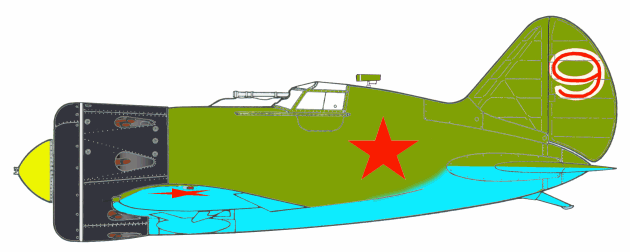
I-16 Type 5 number "9" is one of those pesky aircraft on which I cannot determine
which colour is the actual numeral, and which is the trim! Is it "Red 9"; "White
9"? I really do not know. Number "9" was thought to belong to the Navy's 12
IAP of the Baltic Fleet, and was photographed in August 1937.
This aircraft was finished in a typical AII Green over Blue finish (or, possibly the earlier AEh lacquers of similar colour; the appearance of these paints was quite close, so this detail is not critical from a modeling perspective) of a worn shade, and has a black cowling. The numeral is unusually large, but in this photograph's line-up such a feature appears to be entirely normal. The spinner looks to be yellow (white spinners are also present on some other aircraft).
Many of the machines in this photo are fitted with an SL-17 camera. As well, many of the crew are turned out in their dress uniforms. It is possible that the photo was taken on the occasion of the VMF's aerial gunnery competition for 1937, which was indeed hosted by the Baltic Fleet (KBF) in August. Otherwise, the appearance of so many gun-cameras on Type 5 aircraft is rather unusual.
Number "9" wears plain red national star markings in six positions, including
the wing upper surfaces. The appearance is rather neat, and despite some small
wear the aircraft is well cleaned.
I-16 Type 5 "Red 891"
Pilot unknown
unit unknown
ca. summer 1941
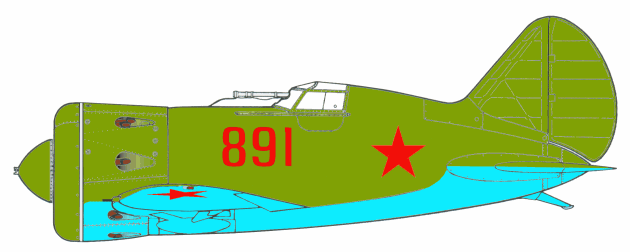
This I-16 Type 5 was photographed during the later summer of 1941, and looks
to have crash-landed some time near the onset of the Barbarossa invasion.
The photo was taken by a German, and the aircraft is shown by that time in a
somewhat dilapidated condition.
The unusually large tactical number of "891" was a curious feature somewhat in vogue in certain units that participated in the Polish occupation during 1939, a fact which may well point to the possible identity of the owner of this aircraft. The scheme appears to be typical for the 1940-41 time frame, suggesting that the finish was not the original one from the time of manufacture. The colour demarcation on the cowl is also inconsistent with the usual factory finishing practices of the time when this aircraft would have been built, as are the locations of the national markings. The colours appear to be a worn shade of AII Green, with Blue underneath.
The number "891" is presented in red. Plain red type national markings are
worn in four positions (not on the wing upper surfaces), as shown.
I-16 Type 5 "White 1"
Pilot Maj. P. Petrov
33 IAP
ca. September 1940
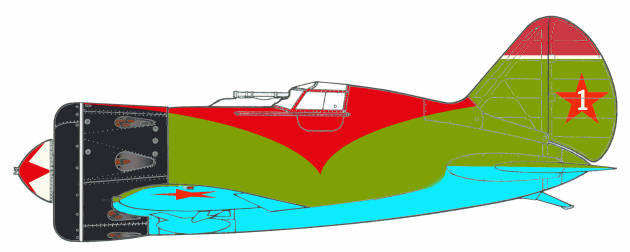
One of my very favourite aircraft schemes of the entire period, "White 1" was
the personal mount of Regimental Commander Pavel Petrov during 1940. The aircraft
was photographed during some kind of official parade, and the unit is turned
out in the photo in their best dress.
"White 1" was spectacularly trimmed in red, the largest feature of which was a diamond shaped application extending over the top of the fuselage from the cowl ring to the fin. The canopy framing was painted, as well, but as usual showed considerable wear and paint flaking. A darker red colour was applied as a flash to the fin/ruder, this smartly trimmed in white. The tactical numeral "1" was presented in white over the national star marking, this appearing quite attractively on the rudder. The spinner, as well, wore a superb star feature in the classic 1936-38 fashion.
Petrov's Type 5 was finished in a typical factory application of the time in
AII (or AEh) Green over Blue. The cowl was black, as was so common during this
period, and the green shade was of the worn variety. National markings were
worn in six positions, including the wing upper surfaces.
I-16 Type 5 "Red 7"
Pilot St.Lt. I. Tupikov (?)
158 IAP
ca. late 1938
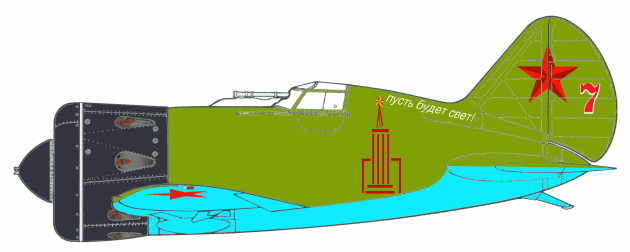
This very dramatic I-16 Type 5 was photographed in the fall/winter of 1938 in
the Pskov area, most likely with the 158 IAP. The pilot is not recorded on the
photograph caption, but another reputable author has attributed this aircraft
to Igor Tupikov (who was indeed in this unit at the time, and who later became
a HSU following a "ground taran" in 1941 after being mortally wounded in the
air), and this claim seems to be entirely plausible.
"Red 7" wears another very typical AII Green/Blue application with a black cowling, and the finish is entirely usual for the period. The fuselage sports an intriguing piece of artwork, this clearly a stylized conceptualization of some significant building. No one yet seems to be certain which building is depicted here (perhaps a spire at the Kremlin, or the never completed Dom Sovietov, or..?), but the monumental lines of 1930's Soviet architecture are evident. The spine features the inscription "pust' budet svet!" ("let there be light!") in white.
The tactical numeral is presented on the rudder in red, trimmed with white.
The star across the fin/rudder is a rather attractive unbordered 'Kremlin' type,
while plain red star markings appear on the wing upper and lower surfaces.
I-16 Type 5 "White 606"
Pilot unknown
Hangkow Special Defense
ca. August 1938
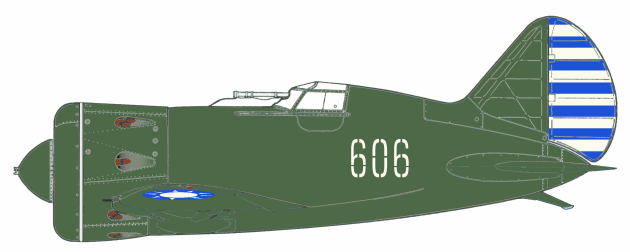
This aircraft was photographed in the fall of 1938 in service with the Chinese
Air Force as part of the Hangkow Special Defense unit, which included a number
of Soviet volunteer pilot-instructors. The pilot of "606" is not recorded.
"White 606" is pictured in a line-up of aircraft, a mix of Soviet camouflaged Type 10s, and several Types 5s wearing the classic Chinese grey-green colouration. The camouflage employed in some cases by the Chinese is a dream come true for devotees of single-colour finish--and I do mean single colour: this paint was applied over the entire aircraft, wheels, tyres, engine, propeller... everything. Number "606" was thusly finished.
The rudder demonstrates the usual Chinese national stripes in blue/white, and
Chinese national markings appear on the wing upper and lower surfaces.
I-16 Type 5 "Black 5"
Pilot Maior A. Blagoveschenskiy
22 IAP
May-June 1938
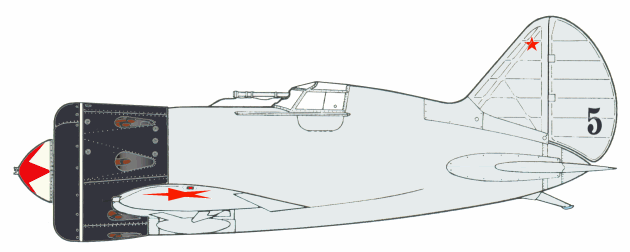
This attractive I-16 Type 5 was photographed in the Lake Khasan region in the
summer of 1938, following the infamous events of May. Though not then at the
original airfield of the "strafing" incident, the appearance of "Black 5" was
unchanged.
Aleksei Blagoveschenskiy was originally deployed to the Lake Byur and Lake Khasan area as a Kapitan, and quickly was promoted to Maior in charge of fighter operations within the 27 SAD. Throughout the build-up of Soviet forces during 1937-38, Japanese aircraft were in the habit of flying near the airfield north of Lake Khasan and "inspecting" the doings there. Occasionally, these Japanese flights were met with anti-aircraft fire (such as was present), but little note was taken of them. In May 1938 (the exact date is in dispute; the 11th or 18th, depending upon the source) two such "Japanese Army Biplanes" (probably Ki.10s) appeared, as usual. Blagoveschenskiy was on the flight-line with his pilots, and suddenly the Japanese machines attacked, attempting to strafe and then bomb Blagoveschenskiy [to this day, Russian pilots insist that this was an assassination attempt], specifically it seems. Blagoveschenskiy and another Lietenant managed to roar off after them in two I-16s, and shoot down both assailants; the former piloting "Black 5".
Blagoveschenskiy's "5" was finished in the pre-War AEh-9 over-all livery, a
scheme seen not infrequently during 1936-39. The cowling was black, as was usual
for this application, and national star markings were worn on the wing upper
and lower surfaces. A very small national star appeared on the fin, which was
not typical. This type of 'miniature' star came into vogue in the various Polikarpov
programmes at certain times, notably on the I-152 during 1939 manufacture, and
was seen elsewhere occasionally. The white spinner with the large red star was
all the rage in 1936-38 on I-16s, and many aircraft of the period are seen with
this type of unit. The propellor blades appear to have been unpainted in this
case.
I-16 Type 5 "No. 7"
Pilot unknown
unit unknown
ca. November 1936
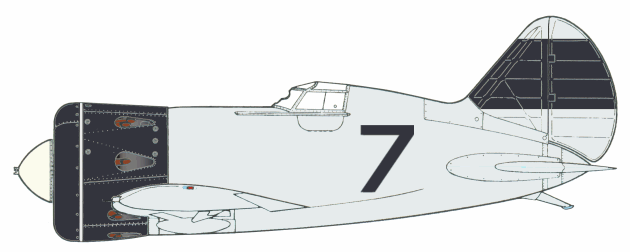
I-16 Type 5 "No.7" was photographed in Barajas, Spain, in November 1936. The
aircraft is shown without its telescopic gunsight, but in all other respects
seems to have been an operational machine.
The colouration of the markings on "7" are, alas, somewhat in dispute. The
number is typically regarded as being black in colour, which is entirely likely
(black was preferred on VVS fighters for the tactical number when using the
AEh-9 scheme). The large stripe on the fin/rudder, perhaps to cover a red star
marking, is also usually depicted as such. However, "No.7" was photographed
on orthochromatic film, almost certainly of French or Spanish manufacture. Therefore,
it is impossible to say what colour these items may be; red would be indistinguishable
on this type of film from black, and yellow would be similar (but not exact).
Several Russian artists who have drawn this machine have inferred a red stripe
on the fin/rudder, and it must be said that this is possible.
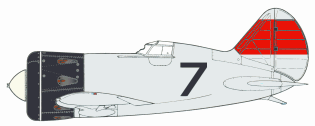
Be that as it may, "7" was finished in the AEh-9 over-all livery with a black
cowling. The spinner appears to be white, but does not demonstrate the classic
star feature of that time. It is said that the entire first batch of 31 I-16
fighters to Spain were delivered in this colouration, and served over Madrid
in this appearance.
I-16 Type 5 "CM-125"
Pilots Morales, Zarauza
4a Escuadrilla de Moscas
ca. ?
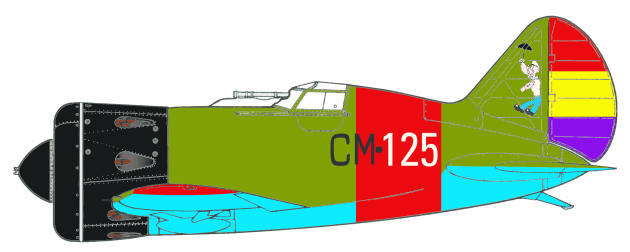
"CM-125" was another 4th Squadron I-16, probably as it appeared in 1938. The
pilots are said to include both Morales and Zaruza, but alas I do not know any
more of the details about this aircraft.
"125" was finished in a classic scheme of the period, with AII Green over Blue
and a Black cowling. This aircraft continued the tradition of 4th Squadron "Popeye"
motifs, and in this case he has an umbrella. Some of these "Popeye" figures
are said to be represented on the starborad side, as well; I do not know if
this aircraft was so finished.
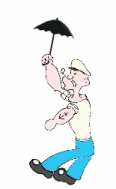
Investigations on this aircraft will continue, and will be updated as they materialize.
I-16 Type 5 "Black 37"
Pilot ?
4a Escuadrilla de Moscas
ca. ?
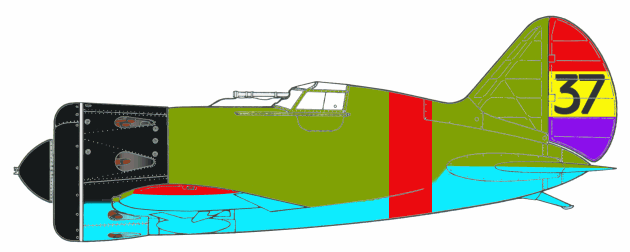
This machine was also a 4th Squadron member, but from an earlier period. It
is thought that the aircraft dates from 1937, or very early 1938, and shows
the more usual appearance of that time. The pilot of "37" is currently unknown.
"Black 37" seems to have been finished again in a classic AII scheme--Green/Blue--with a Black cowling. However, the lower cowl is painted with Blue, which is quite unusual. I suspect that this was not done at the factory, and may represent some type of replacement unit, or some other repainting in Spain. The Republican stripes are rendered here in a thin manner, and there is no "CM" number present on the fuselage. Instead, a number appears on the rudder, and several other 4th Squadron machines from this time are also marked in this way.
Further investigations on this aircraft will continue, and will be updated as they materialize.